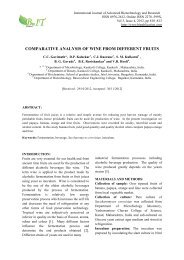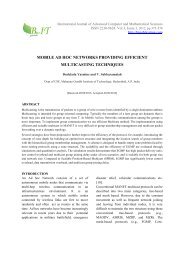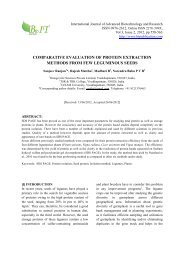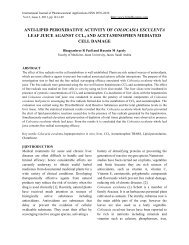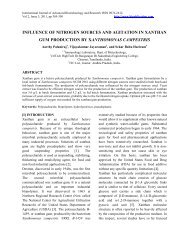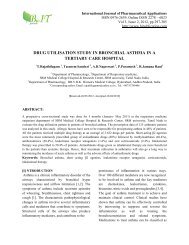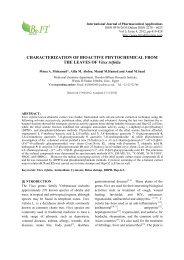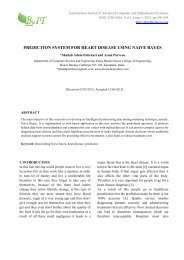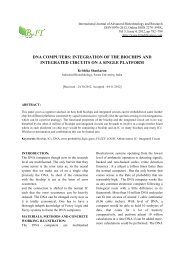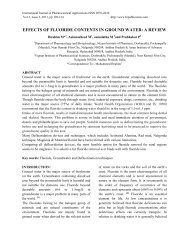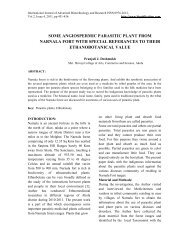COMPARATIVE STUDY OF PRODUCTION OF WINE FROM MILK ...
COMPARATIVE STUDY OF PRODUCTION OF WINE FROM MILK ...
COMPARATIVE STUDY OF PRODUCTION OF WINE FROM MILK ...
You also want an ePaper? Increase the reach of your titles
YUMPU automatically turns print PDFs into web optimized ePapers that Google loves.
<strong>COMPARATIVE</strong> <strong>STUDY</strong> <strong>OF</strong> <strong>PRODUCTION</strong> <strong>OF</strong> <strong>WINE</strong> <strong>FROM</strong> <strong>MILK</strong> AND WATER <strong>OF</strong> Cocos nucifera L.fermenting crushed grapes using various types ofyeast. Yeast consumes the sugars in the grapesand converts them into alcohol. Wine has a richhistory dating back thousands of years, with theearliest known production occurring around8,000 years ago on the territory of modern-dayGeorgia.[15, 24] Wine has also played animportant role in religion throughout history.The coconut (Cocos nucifera L.) is an importantfruit tree in the tropical regions and the fruit canbe made into a variety of foods and beverages.The edible part of the coconut fruit (coconut meatand coconut water) is the endosperm tissue.Endosperm tissues undergo one of three mainmodes of development, which are the nuclear,cellular and helobial modes [4, 14, 16] and thedevelopment of coconut endosperm belongs tothe nuclear mode. Initially, the endosperm is aliquid containing free nuclei generated by aprocess, in which the primary endosperm nucleusundergoes several cycles of division withoutcytokinesis. At first, the cellular endosperm istranslucent and jelly-like, but it later hardens atmaturity to become white flesh (coconut meat).Unlike the endosperms of other plants (e.g.,wheat and corn), the cellularization process in acoconut fruit does not fill up the entire embryosac cavity, but instead leaves the cavity solutionfilled.This solution is commonly known ascoconut water and it is of cytoplasm origin [6,10]. Nutrients from coconut water are obtainedfrom the seed apoplasm (surrounding cell wall)and are transported symplasmically throughplasmodemata, which is the connection betweencytoplasm of adjacent cells) into the endosperm[7]. Coconut water is the clear liquid insideyoung coconuts (fruits of the coconut palm). Asthe fruit matures, the coconut water is graduallyreplaced by the coconut meat and air. Coconutmilk is usually used as a food ingredient invarious traditional cooking recipes (The maincomponents of coconut milk are water, fat andprotein. whereas coconut water contains mainlywater. The aqueous part of the coconutendosperm is termed coconut water, whereascoconut milk refers to the liquid productsobtained by grating the solid endosperm, with orwithout addition of water. Also the Coconutwater has been known to have health benefitssuch as maintain the body at the propertemperature, carry nutrients and oxygen to cells,naturally replenish your body's fluids afterexercising, Promote weight loss, Boost yourimmune system, Cleanse your digestive tract,Treat kidney and urethral stones.[20] Wines madethrough single-yeast inoculation differ in sensoryproperties to those made by spontaneousfermentations, an observation reinforced bydifferences in chemical composition [21, 22, 25].This paper deals with the work of production ofCoconut Wine which is combination of these twoproducts. This paper mainly highlightsproduction of wine from coconut water &coconut milk which will be healthy andrefreshing drink.II. MATERIALS AND METHODS-2.1. For Coconut water wine2.1. 1.Collection of Coconut water- The firststep of this project was to collect raw materialwhich is coconut water from selected youngcoconuts. We have collected totally 5lit ofcoconut water from about 22 coconuts. Then itwas tested to determine BRIX i.e. sugarconcentration by using Refractometer. The initialBrix observed was 1%. The aim was to obtain thefinal Brix of solution up to 18%, so addition of850 grams of sugar. Again testing the solutionwith the help of Refractometer desired Brixpercent was confirmed. After the Brix adjustmentthe solution was kept for sterilization at 80 0 C for5 min in water bath. To complete the sterilizationit was then kept for cooling and 0.1g ofpotassium meta bisulphate was added.2.1.2. Inoculum preparation- Inoculumpreparation was done by activating Yeast in thehot water having temperature 40 0 c and somecoconut water was also added. Then 0.5 gm ofWine Yeast was added to above solution. MixtureVishu J. Gaikwad, et al. 275



